Directed Energy Weapons Market Research, 2032
The global directed energy weapons market size was valued at $4.9 billion in 2022, and is projected to reach $22.2 billion by 2032, growing at a CAGR of 16.4% from 2023 to 2032. A directed energy weapon (DEW) is a type of weapon that utilizes focused energy, such as lasers, microwaves, or particle beams, to effectively destroy, incapacitate, or harm its intended target. Examples of DEWs include high-energy lasers, electromagnetic rail guns, and high-power microwaves or ultra-wideband weapons. These weapons possess the crucial characteristic of rapid response capability, allowing them to counter threats swiftly. Graded responses, such as precision targeting, missile interception, and adaptable reactions, enable DEWs to engage approaching missiles, personnel-targeting weapons, vehicles, and optical devices from long distances. 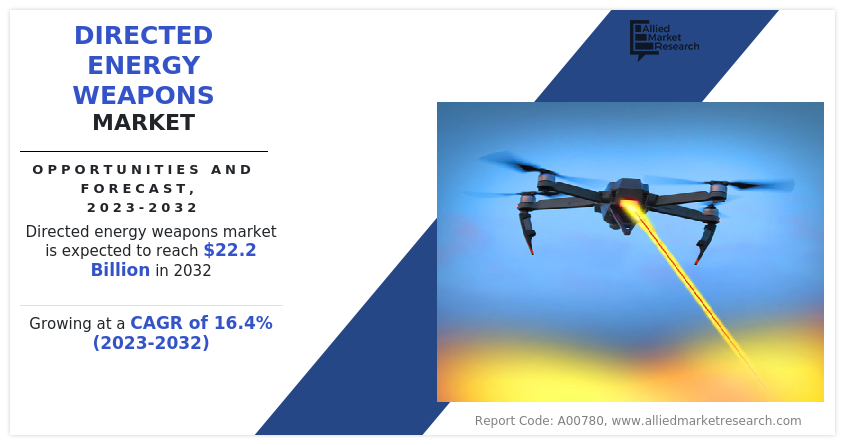
Factors such as increase in demand for directed energy weapons to achieve precise targeting and reduced collateral damage, rise in security threats posed by terrorist organizations, and surge in the adoption of directed energy weapons in navy drive the directed energy weapons market growth.
However, technological limitations, and ethical and health concerns hinder the growth of the market. Furthermore, the technological advancements and continuous research, and integration of directed energy weapons with conventional weapons offer remarkable growth opportunities for the players operating in the directed energy weapons market.
The directed energy weapons market is segmented on the basis of technology, platform, product, and region. By technology, it is divided into high energy laser, high power microwave, and others. By platform, it is fragmented into land, airborne, and navy. By product, it is bifurcated into lethal, and non-lethal. By region, the directed energy weapons market is analyzed across North America, Europe, Asia-Pacific, and LAMEA.
Report Key Highlights:
The directed energy weapons market studies more than 15 countries. The research includes a segment analysis of each country in terms of value ($ million) for the projected period 2022-2032.
- The study integrated high-quality data, professional opinions and analysis, and critical independent perspectives. The research approach is intended to provide a balanced view of global markets and to assist stakeholders in making educated decisions to achieve their most ambitious growth objectives.
- Over 3,700 product literature, annual reports, industry statements, and other comparable materials from major industry participants were reviewed to gain a better understanding of the directed energy weaponsmarket.
- The directed energy weapons market share is moderately fragmented, with several players including Northrop Grumman, BAE Systems, Rheinmetall AG, Thales Group, Leonardo S.p.A., MBDA, Boeing, RTX, QinetiQ, and Lockheed Martin Corporation. Key strategies such as agreement, product upgrade, partnership, contract, and other strategies of the players operating in the market are tracked and monitored.
Key Market Players
The leading companies profiled in the directed energy weapons market report include Northrop Grumman, BAE Systems, Rheinmetall AG, Thales Group, Leonardo S.p.A., MBDA, Boeing, RTX, QinetiQ, and Lockheed Martin Corporation. The companies have adopted strategies such as agreement, product upgrade, partnership, contract, and others to improve their market positioning.
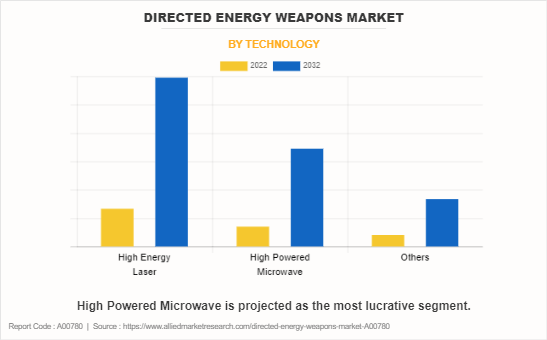
North America includes the U.S., Canada, and Mexico. Military entities in the counties of the region are consistently developing technological innovations to achieve a competitive advantage in combat situations. For instance, in June 2022, U.S. Army is working on developing and fielding directed-energy weapons, including prototypes such as the Multi-Mission High Energy Laser. This prototype is a retrofit of a modified Stryker vehicle with a 50-kilowatt laser.
The U.S. military is also collaborating with various agencies, services, and industry partners to advance the technology further, aiming for even more powerful solid-state lasers and high-powered microwave weapons with energy levels of 100 kW and beyond. Therefore, rise in collaborations between the defense sector and manufacturers to develop advanced, high-efficiency laser weapons is expected to drive the growth of the market.
Numerous countries in the region aim to promote technological advancements in defense and military domains. The initiative encompasses substantial financial commitments directed towards research and development, fostering advancements in cutting-edge technologies, including directed energy weapons.
As indicated by reports from the U.S. Government Accountability Office, the U.S. Department of Defense dedicates an annual budget of approximately $1 billion for the progression of technologies categorized as "directed energy." Additionally, there is a growing emphasis on research, development, and the integration of directed energy weapons within organizations such as the U.S. Department of Defense and other defense agencies.
In addition, manufacturers collaborate with the defense sector to test and deploy advanced laser weapons. As of June 2023, Raytheon Technologies achieved the creation of a palletized high-energy laser weapon named "H4."
In partnership with Raytheon Technologies, the U.S. Air Force Life Cycle Management Center executed a successful test of the first-ever palletized high-energy laser weapon for the Air Force. This weapon is designed to emit a 10-kilowatt laser beam, crafted to meet the specific requirements of the U.S. military.
The directed energy weapons market analysis encompasses Europe, including the UK, Germany, France, Russia, and other regions within Europe. The directed energy weapons market is expected to witness growth in the region owing to the increase in the research, development, and testing of laser weapons to enhance security. Moreover, the navy forces across various nations of the region are increasingly exploring and investing in directed energy weapons (DEWs). For instance, in January 2021, Rheinmetall, a defense technology provider, and MBDA Deutschland, a European defense company, established a consortium called ARGE to collaborate on building and testing a high-energy laser weapon system for the German Navy.
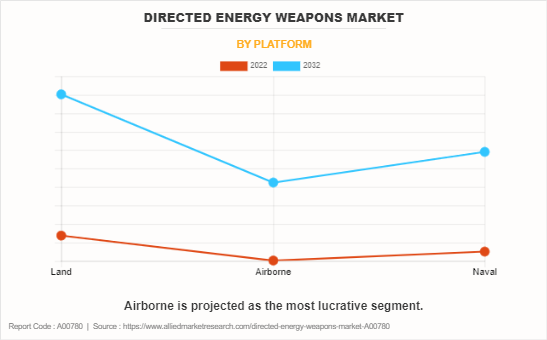
Numerous European nations have been allocating resources to research and develop directed energy weapons technology. These countries are investigating the potential of laser weaponry for military purposes.
Moreover, collaborative efforts among European nations in defense projects are expected to increase the advancement and exchange of directed energy weapons technology. In addition, there is a surge in the number of collaborations between manufacturers and defense sectors of various countries in Europe to develop advanced directed energy weapons that is capable of defending against various threats, including drones.
For instance, in November 2022, the German military disclosed the use of a shipboard laser weapon. Developed through collaboration between MBDA and Rheinmetall, this high-energy laser (HEL) system marks a significant advancement. The laser weapon demonstrator is designed with the principal aim of offering protection against diverse threats, such as drones, drone swarms, close-range attacking speed boats, guided missiles, and mortar rounds.
Furthermore, the increasing trend in crafting laser weapon solutions tailored for armed forces and security entities is foreseen as a key factor propelling market expansion in the region.
Increase In Demand For Directed Energy Weapons To Achieve Precise Targeting And Reduced Collateral Damage
The surge in demand for directed energy weapons stems from the compelling need to achieve precision in targeting capabilities while concurrently mitigating collateral damage. Conventional kinetic armaments, including missiles and explosives, frequently result in inadvertent harm and civilian casualties, thereby triggering ethical and strategic apprehensions. In contrast, directed energy weapons hold the promise of engaging and incapacitating specific objectives with exceptional accuracy, thereby minimizing the likelihood of unintentional harm to non-combatants and vital infrastructure.
Directed Energy Weapons (DEWs) exhibit precision when engaging swiftly moving targets, setting them apart from conventional weaponry which makes them a suitable choice.
Furthermore, DEWs possess advantages such as unlimited firing capacity, the ability to cover multiple target zones, and silent operation. These systems find extensive utilization across various platforms including ground vehicles, naval vessels, aircraft, and unmanned vehicles.
DEWs can also serve as non-lethal instruments employing millimeter and microwave technologies to incapacitate soldiers and neutralize enemy electronic systems. This versatile array of applications highlights the potential for DEWs to revolutionize modern warfare and security strategies. Therefore, such advantages provided by directed energy weapons are expected to drive the growth of the market.
Rise In Security Threats Posed By Terrorist Organizations
The growth of the directed energy weapons market is driven by the escalating security threats posed by terrorist organizations. In 2022, terrorist attacks displayed increased lethality, averaging 1.7 fatalities per attack—an uptick from the 1.3 deaths per attack reported in 2021, according to the Office for the Coordination of Humanitarian Affairs, reflecting a 26% increase.
Additionally, data from the National Institute of Health in the U.S. reveals a surge in the use of unmanned aerial vehicles (UAVs) in terrorist activities. On average, 1.28 UAVs were utilized in an attack, and multiple UAVs were deployed in 22% of instances. The rising prevalence of terrorist groups employing UAVs for reconnaissance, surveillance, and diverse operations underscores the dynamic evolution of security threats.
Directed energy weapons offer a valuable solution to counter these activities by incapacitating or eliminating unauthorized UAVs. This enhances the protection of vital infrastructure, public gatherings, and military sites. In addition, utilizing directed energy weapons is expected to strengthen border security by deterring and incapacitating potential infiltrators. The extended range and precision of the weapons make them highly suitable for surveilling and safeguarding vast borders from unauthorized incursions. Therefore, the rise in security threats from terrorist organizations is expected to increase the demand for directed energy weapons.
Technological Limitations
Technological limitations exert a significant restraint on the growth of the market. These constraints originate from the present capabilities and confines of prevailing technologies, thereby impeding the broad acceptance and efficacy of specific advancements. Certain technologies may not currently meet the performance benchmarks essential for particular applications.
Power consumption poses a significant hurdle for laser weapon systems. These systems demand a substantial energy supply to generate the intense energy beam. Supplying such vast amounts of power is challenging, and ensuring a consistent power source on the battlefield when needed adds an even greater level of complexity.
These weapons demand substantial power resources for optimal operation, and technological restrictions in power creation, storage, and transmission can compromise their functionality and endurance, impacting their viability in practical situations. The generation of intense heat during directed energy weapon operation requires efficient cooling mechanisms.
Technological limitations in thermal management can affect the performance of the weapon and longevity. Technologically complex systems can be prone to malfunctions and require sophisticated maintenance. Ensuring the reliability of directed energy weapons under various operational conditions is a technological hurdle. Therefore, all such technological limitations during the development and maintenance of directed energy weapons are expected to hamper the growth of the market.
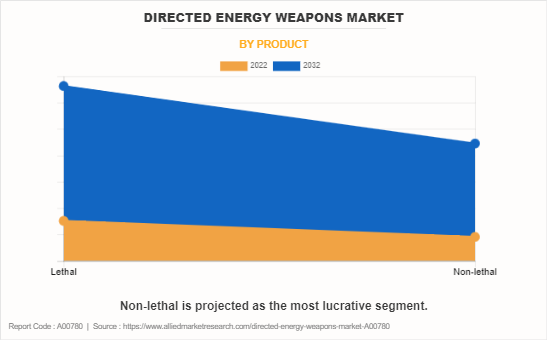
Ethical And Health Concerns
Ethical and health-related worries serve as significant factors constraining the progress of the market, especially in domains such as directed energy weapons. These concerns revolve around the ethical consequences and possible health hazards linked to the application and utilization of these technologies. The introduction of directed energy weapons brings about the possibility of unintentional harm to individuals not directly targeted. This scenario prompts ethical considerations about the appropriateness of using force and the potential for unintended civilian casualties or damage to non-targeted assets.
In addition, the effects on health due to exposure to directed energy emissions, like powerful lasers or microwaves, are not entirely comprehended. Potential enduring health risks for both operators and unintended recipients of such energy raise ethical queries concerning the responsible deployment of such technology.
Technological Advancements And Constant Research
Technological progress and persistent research offer significant opportunities for market expansion and advancement. There is a rise in ongoing enhancements and innovations across different areas of the laser weapon industry, which is expected to promote the evolution of directed energy weapons and their uses.
Technological advancements are anticipated to significantly increase the overall proficiency of directed energy weapons, their range, power output, and targeting precision. Moreover, technological advancements provide energy-efficient configurations for directed energy weapons, extending their operational endurance.
This advantage is expected to be beneficial for longer missions where sustained functionality is crucial. Moreover, there's an increasing focus on studying directed energy weapons (DEWs) in various countries and organizations. For instance, in February 2019, U.S. Senator Martin Heinrich revealed that Tau Technologies in Albuquerque secured an $8.9 million contract from the U.S. Air Force. Their task is to use directed energy modeling for cross-domain analysis at the Air Force Research Laboratory.
Directed energy modeling involves using computer simulations and mathematical models to understand how directed energy weapons perform in different situations across land, air, sea, space, and cyber domains. This kind of research helps us grasp the strengths and limitations of these weapons, fostering innovation and technological advancements that are expected to drive the market's growth.
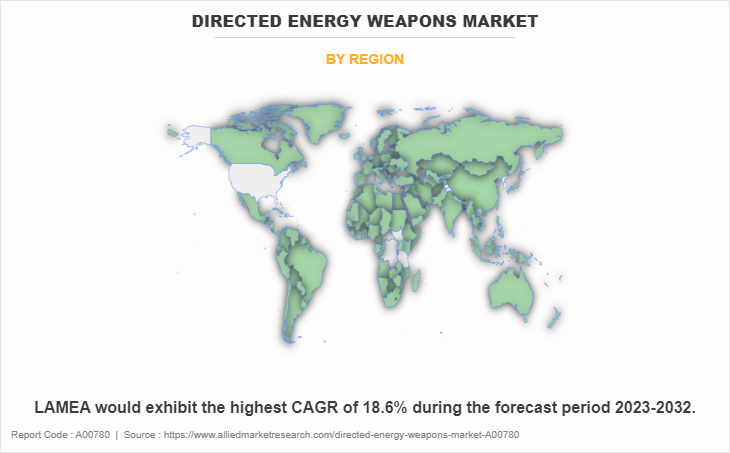
Recent Developments in Directed Energy Weapons Industry
In April 2023, QinetiQ received contract by Defense Science and Technology Group (DSTG) to collaborate with the Department of Defense to co-develop and manufacture a high energy defensive laser system prototype in South Australia.
In January 2023, BAE Systems signed a contract of $12 million with Air Force Research Laboratory (AFRL) to develop advanced seeker for maritime targeting from air-launched platforms. It is low cost, all-weather, multi-mode (radar/infrared) open architecture seeker under the Maritime Weapon Innovation Program (MWIP).
In November 2022, Leonardo S.p.A. with MBDA and QinetiQ entered into partnership with MOD's Defense Science and Technology Laboratory (Dstl) to develop new directed energy weapon technologies under project UK DragonFire. So far, Leonardo delivered two prototype UK DragonFire beam directors.
In September 2021, Thales and Raytheon UK received contract by Ministry of Defense of UK to manufacture advanced laser and radio frequency demonstrators as part of the Novel Weapons Programme (NWP). These four-year contracts create at least 49 new jobs and sustain 249 jobs.
In January 2021, Rheinmetall AG entered into partnership with MBDA Deutschland to builds high-energy lasers for Germany's Navy.
In September 2021, Thales and Raytheon UK received contract by Ministry of Defense of UK to manufacture advanced laser and radio frequency demonstrators as part of the Novel Weapons Programme (NWP). These four-year contracts create at least 49 new jobs and sustain 249 jobs.
In October 2020, RTX received contract by Air Force Research Laboratory (AFRL) to experiment with its directed-energy weapon prototype called the Counter-Electronic High Power Microwave Extended Range Air Base Air Defense (CHIMERA).
Key Benefits For Stakeholders
This report provides a quantitative analysis of the market segments, current trends, estimations, and dynamics of the directed energy weapons market analysis from 2022 to 2032 to identify the prevailing directed energy weapons market opportunities.
The market research is offered along with information related to key drivers, restraints, and opportunities.
Porter's five forces analysis highlights the potency of buyers and suppliers to enable stakeholders make profit-oriented business decisions and strengthen their supplier-buyer network.
In-depth analysis of the directed energy weapons market segmentation assists to determine the prevailing market opportunities.
Major countries in each region are mapped according to their revenue contribution to the global market.
Market player positioning facilitates benchmarking and provides a clear understanding of the present position of the market players.
The report includes the analysis of the regional as well as global directed energy weapons market trends, key players, market segments, application areas, and market growth strategies.
Directed Energy Weapons Market Report Highlights
| Aspects | Details |
| Market Size By 2032 | USD 22.2 billion |
| Growth Rate | CAGR of 16.4% |
| Forecast period | 2022 - 2032 |
| Report Pages | 230 |
| By Technology |
|
| By Platform |
|
| By Product |
|
| By Region |
|
| Key Market Players | Leonardo S.p.A., Rheinmetall AG, Thales Group, Lockheed Martin Corporation, Boeing, BAE Systems, Northrop Grumman, QinetiQ, RTX, MBDA |
Factors such as increase in demand for directed energy weapons to achieve precise targeting and reduced collateral damage, rise in security threats posed by terrorist organizations, and surge in the adoption of directed energy weapons in navy drive the directed energy weapons market growth.
By region, LAMEA is anticipated to register the highest CAGR during the forecast period.
The leading companies profiled in the report include Northrop Grumman, BAE Systems, Rheinmetall AG, Thales Group, Leonardo S.p.A., MBDA, Boeing, RTX, QinetiQ, and Lockheed Martin Corporation.
The global directed energy weapons market is growing at a CAGR of 16.4% from 2023 to 2032.
The global directed energy weapons market size was valued at $4.9 billion in 2022, and is projected to reach $22.2 billion by 2032, growing at a CAGR of 16.4% from 2023 to 2032.
Loading Table Of Content...
Loading Research Methodology...



